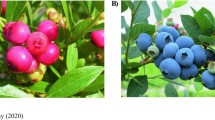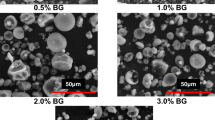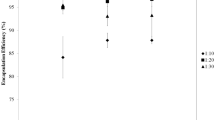Abstract
Blackberry aqueous extract acidified with 2 % citric acid was spray-dried using gum Arabic (GA) and polydextrose (PD) as encapsulating agents at concentrations of 10 and 15 % and temperatures of 140 to 160 °C. All powders presented high solubility, ranging from 88.2 to 97.4 %, and the encapsulation conditions did not significantly affect the hygroscopicity. The powders produced with gum Arabic showed higher brightness than those with polydextrose. The anthocyanins retention in the microcapsules was 878.32 to 1300.83 mg/100 g, and the phenolics was 2106.56 to 2429.22 mg (GAE)/100 g. The antioxidant activity was quantified according to DDPH and ABTS methods, with values ranging from 31.28 to 40.26 % and 27 to 45.15 %, respectively. The microscopy showed spherical particles for both encapsulating agents, and smooth surface with some concavities with the gum Arabic, and smooth or slightly rough surface when using polydextrose. The Pearson correlation coefficient showed a high correlation between the color parameters, L*, a*, b*, Hue, Chroma and browning index (BI), which were also strongly correlated with anthocyanins. Phenolic presented correlation with DPPH and ABTS values. The results showed that the best encapsulation condition was atomization at 140 °C and 15 % gum Arabic.




Similar content being viewed by others
References
Adams JB (1973) Thermal degradation of anthocyanins with particular reference to the 3-glycosides of cyanidin. I. In acidified aqueous solution at 100 °C. J Sci Food Agric 24:747–762
Aguilera JM, Stanley DW (1999) Microstructural principles of food processing and engineering. Aspen, Gaithersburg, 432 p
Ahmed M, Akter MS, Lee JC, Eun JB (2010) Encapsulation by spray drying of bioactive components, physicochemical and morphological properties from purple sweet potato. LWT Food Sci Technol 43:1307–1312
Badreldin HA, Ziada A, Blunden G (2009) Biological effects of gum Arabic: a review of some recent research. Food Chem Toxicol 47:1–8
Brand-Williams W, Cuvelier ME, Berset C (1995) Use of a free radical method to evaluate antioxidant activity. LWT Food Sci Technol 28:25–30
Cano-Chauca M, Stringheta PC, Ramos AM, Cal-Vidal J (2005) Effect of the carriers on the microstructure of mango powder obtained by spray drying and its functional characterization. Innov Food Sci Emerg 6:420–428
Caparino OA, Tang J, Nindo CI, Sablani SS, Powers JR, Fellman JK (2012) Effect of drying methods on the physical properties and microstructures of mango (Philippine ‘carabao’ var.) powder. J Food Eng 111:135–148
Dangles O, Brouillard R (1992) A spectroscopic method based on the anthocyanin copigmentation interaction and applied to the quantitative study of molecular complexes. J Chem Soc Perkin Trans 2:247–257
Elisia I, Hu C, Popovich DG, Kitts DD (2007) Antioxidant assessment of an anthocyanin-enriched blackberry extract. Food Chem 101:1052–1058
Fang Z, Bhandari B (2011) Effect of spray drying and storage on the stability of bayberry polyphenols. Food Chem 129:1139–1147
Fang Z, Bhandari B (2012) Comparing the efficiency of protein and maltodextrin on spray drying of bayberry juice. Food Res Int 48:478–483
Fazaeli M, Emam-Djomeh Z, Ashtari AK, Omid M (2012) Effect of spray drying conditions and feed composition on the physical properties of black mulberry juice powder. Food Bioprod Process 90:667–675
Francis FJ (1989) Food colorants: anthocyanins. Crit Rev Food Sci Nutr 28:273–314
Giusti MM, Wrolsted RE (2001) Anthocyanins: characterization and measurement with UV–visible spectroscopy. In: Wrolstad RE, Schwartz SJ (eds) Current protocols in food analytical chemistry. Wiley, New York, pp. 1–13
He J, Giusti MM (2010) Anthocyanins: natural colorants with health-promoting properties. Annu Rev Food Sci Technol 1:163–187
Huang W, Zhang H, Liu W, Li C (2012) Survey of antioxidant capacity and phenolic composition of blueberry, blackberry, and strawberry in Nanjing. J Zhejiang University 13:94–102
Ivanovic J, Tadic V, Dimitrijevic S, Stamenic M, Petrovic S, Zizovic I (2014) Antioxidant properties of the anthocyanin-containing ultrasonicextract from blackberry cultivar “cacanska bestrna”. Ind Crop Prod 53:274–281
Jakobek L, Seruga M, Seruga B, Novak I, Medvidovic-Kosanovic M (2009) Phenolic compound composition and antioxidant activity of fruits of rubus and prunus species From Croatia. Int J Food Sci Technol 44:860–868
Jiménez-Aguilar DM, Ortega-Regules AE, Lozada-Ramírez JD, Pérez-Pérez MCI, Vernon-Carter EJ, Welti-Chanes J (2011) Color and chemical stability of spray-dried blueberry extract using mesquite gum as wall material. J Food Comp Anal 24:889–894
Kader F, Rovel B, Girardin M, Metche M (1999) Mechanism of browning in fresh highbush blueberry fruit (vaccinium corymbosum L.). role of blueberry polyphenol oxidase, chlorogenic acid and anthocyanins. J Sci Food Agric 74:31–34
Kuck LS, Noreña CPZ (2016) Microencapsulation of grape (Vitis labrusca var. Bordo) skin phenolic extract using gum Arabic, polydextrose, and partially hydrolyzed guar gum as encapsulating agents. Food Chem 194:569–576
Mishra A, Sharma AM, Kumar S, Saxena AK, Pandey AK (2013) Bauhinia variegata leaf extracts exhibit considerable antibacterial, antioxidant, and anticancer activities. BioMed Res Int. doi:10.1155/2013/915436
Moure A, Cruz JM, Franco D, Dominguez JM, Sineiro J, Dominguez H, Núñes MJ, Parajó JC (2001) Natural antioxidants from residual sources. Food Chem 72:145–171
Pascual-Teresa S, Santos-Buelga C, Rivas-Gonzalo JC (2000) Quantitative analysis of flavan-3-ols in Spanish foodstuffs and beverages. J Agric Food Chem 48:5331–5337
Quek SY, Chok NK, Swedlund P (2007) The physicochemical properties of spray-dried watermelon powder. Chem Eng Process 46:386–392
Re R, Pellegrini N, Proteggente A, Panala A, Yang M, Rice-Evans C (1999) Antioxidant activity applying an improved ABTS radical cation decolorization assay. Free Radic Biol Med 26:1231–1237
Ribeiro C, Zimeri JE, Yildiz E, Kokini JL (2003) Estimation of effective diffusivities and glass transition temperature of polydextrose as a function of moisture content. Carbohydr Polym 51:273–280
Rosenberg M, Kopelman IJ, Talmon Y (1985) A scanning electron microscopy study of microencapsulation. J. Food Sci 50:139–144
Singleton VL, Rossi JA (1965) Colorimetry of total phenolics with phosphomolybdic– phosphotungstic acid reagents. Am J Enol Vitic 16:144–158
Sudha G, Vadivukkarasi S, Sheree RBI, Lakshmanan P (2012) Antioxidant activity of various extracts from an edible mushroom pleurotus eous. Food Sci Biotechnol 21:661–668
Toneli JCL, Park KJ, Murr FEX, Negreiros AA (2008) Effect of moisture on the microstructure of inulin powder. Food Sci Technol 28:122–131
Tonon RV, Brabet C, Hubinger MD (2008) Influence of process conditions on the physicochemical properties of açai (euterpe oleraceae mart.) powder produced by spray drying. J Food Eng 88:411–418
Tonon RV, Brabet C, Hubinger MD (2010) Anthocyanin stability and antioxidant activity of spray-dried açaí (Euterpe oleracea mart.) juice produced with different carrier agents. Food Res Int 43:907–914
Tonon RV, Brabet C, Pallet D, Brat P, Hubinger DM (2009) Physicochemical and morphological characterisation of açai (euterpe oleraceae mart.) powder produced with different carrier agents. Int J Food Sci Technol 44:1950–1958
Tsanova-Savova S, Ribarova F, Gerova M (2005) (+)-Catechin and (−)-epicatechin in Bulgarian fruits. J Food Compos Anal 18:691–698
Tulio JAZ, Reese RN, Wyzgoski FJ, Rinaldi PL, Fu R, Scheerens JC, Miller AR (2008) Cyanidin 3-rutinoside and cyanidin 3-xylosylrutinoside as primary phenolic antioxidants in black raspberry. J Agric Food Chem 56:1880–1888
Turemis N, Kafkas E, Kafkas S, Kurkcuoglu M, Baser KHC (2003) Determination of aroma compounds in blackberry by GC/MS analysis. Chem Nat Compd 39:174–176
Wang H, Cao G, Prior RL (1997) Oxygen radical absorbing capacity of anthocyanins. J Agric Food Chem 45:304–309
Wang SY, Lin HS (2000) Antioxidant activity in fruits and leaves of blackberry, raspberry, and strawberry varies with cultivar and developmental stage. J Agric Food Chem 48:140–146
Acknowledgments
This work was supported by FAPERGS, CAPES and CNPq, Brazil.
Author information
Authors and Affiliations
Corresponding author
Rights and permissions
About this article
Cite this article
Rigon, R.T., Zapata Noreña, C.P. Microencapsulation by spray-drying of bioactive compounds extracted from blackberry (rubus fruticosus). J Food Sci Technol 53, 1515–1524 (2016). https://doi.org/10.1007/s13197-015-2111-x
Revised:
Accepted:
Published:
Issue Date:
DOI: https://doi.org/10.1007/s13197-015-2111-x




